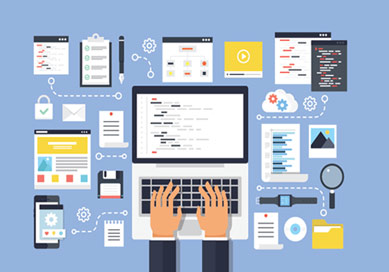A Comprehensive Checklist for Software Development
Developing software is a complex process that can take hundreds of hours to successfully complete. To make sure that the software development is completed so that you get the functionality you need, developers undergo rigorous training programs and work tirelessly to perfect their trade. There are so many moving parts in app and software development that need attention and when one part isn’t working properly, the entire program can fail. To make sure that you’re building a solid framework for your software without expending excessive resources, we recommend utilizing a checklist. With the help of a comprehensive checklist for software development you’ll be able to streamline the process, improve your production time, and create a more cohesive end-result.
Before jumping into the checklist, make sure that you clearly communicate and define your expected budget and timeline for the software development.
17 Action Items: A Checklist for Software Development
The first part of the checklist covers your software’s accessibility and overall functionality. Software accessibility refers to creating a program that people understand how to use. Functionality refers to what the specific software can do for a user and how it helps you communicate your bottom line.

There are five components to this part: network accessibility, data access, hardware access, a research stage, and finally authentication management.
1. Network Accessibility
The first thing you need to do is make sure that whatever software you’re going to develop is able to actually connect to a network. Without network accessibility, no one will be able to access your software. The more accessible this is, the better you’ll be able to connect with users across the world.
Once people come across your software, they’ll need to be able to access the data you’re presenting. However, this access needs to be limited to the public. You need to differentiate data access permissions between users and the software developers so that people can’t edit your software code unless they’ve been granted access.
Regardless of what you develop, you’re going to need to store it on some type of hardware. This helps you back things up and keep your software secure. To boost your data security, you should only allow authorized users access to your hardware—the fewer the people, the better. We recommend only granting hardware access to people who will need to maintain it under your supervision.

4. Research
Next, you’ll need to research all of the requirements and functions that your software will need in order to serve whatever function it’s intended for. Doing the research prior to starting the software development will save you time and streamline the process. It might take a bigger time commitment up front, but it’s the best way to move forward with a strong foundation. Stick to the basics and fine tune the details later on.
5. Authentication Management
The final step in working towards initial accessibility and functionality of your software development is outlining how your users are going to access the software once it’s live. To keep things secure, we recommend using an authentication service that you can trust to help manage data.
The next part of strong software development involves security. You need your site to be as secure as possible, especially with the rise of hackers and data theft. During this part of your software development, you’ll need to create a plan for security, establish said security, utilize hashing, actively prevent data exposure, and then actually secure your accounts.
6. Create a Plan
The first step in establishing secure software development is to create a plan. You need to know exactly how you’re going to store user data and any sensitive or personally identifiable information. When you have a security plan in place, you’ll face fewer risks and adhere to all of the governmental standards required to operate.
7. Establish Security
Once you’ve created a plan, you need to establish software-wide security practices and continually utilize them throughout the programming, coding, developing, and testing processes. If you fail to do so throughout the software development, you could put your program at risk for breaches later on. When you ensure that there are no possibilities for security breaches during development, you’ll reduce the likelihood of backtracking or having to fix problems after they’ve happened.

8. Utilize Hashing
A good way to make sure that your passwords aren’t hackable is to use a hashing algorithm. This is more effective than password encryption, as encryption doesn’t always mean secure protection. Read this article for more information on hashing algorithms.
9. Prevent Data Exposure
You’ll need to make sure that when you access your program from a user’s point of view, no sensitive information is public. You can test this out prior to launching and if you find anything, make sure to fix it immediately.
10. Secure Your Accounts
Finally, increase your account security and limit the accessibility for service and user accounts to safeguard sensitive information. This will help you prevent over exposure.
After you’ve made the software accessible, functional, and safe, you can move on to optimizing it to improve user experience and boost your search engine optimization efforts. The primary facets of software development optimization include the delivery of content, improved scalability, optimize site mapping, choosing designs, keeping records, performing tests, and encrypting keys.
11. Delivering Content
To get the most out of your software development, make sure that you utilize a good content delivery network. This helps make sure that your content is delivered fast and in an optimized way so that users have the best experience possible. Speed and content are some factors that can help set your software program apart from the competition and will increase the benefits for both you and the users.
12. Improving Scalability
Scalability is one of the factors that can make or break a software program. In today’s world, you need to be able to change quickly and adapt as you grow. If your software program isn’t scalable, you’ll end up going back and re-doing a lot of the hard work that you originally put in. To make sure this doesn’t happen, improve the scalability during development so that it has the ability of processing more information and therefore reaching larger audiences when you need it to. Usually, developers will include scalability in the research phase, but it’s worth mentioning again here as it’s crucial for the long-term success of your program.
13. Optimize Site Mapping
Your software program should have a clearly organized and optimized site map so that you can go in and make changes later without messing up the underlying code. A clean object-related-mapping (ORM) allows for better long-term maintenance and fewer editing errors later on.
14. Saving Designs
Once you develop the site design, make sure that you save it. This gives you a chance to make minor edits or adjustments when you want to re-use the coded design or update it later on. It also gives your developers an original blueprint in case something goes wrong during updates and needs to be reverted.
15. Record Keeping
If you’re going to use externally sourced codes, make sure that you keep a record of what you’re using alongside any of the licensing terms that those codes require.
16. Performing Tests
Before launching your program run multiple tests to make sure there are no technical problems before going live. If you launch and have a page or program filled with site errors, you’re going to harm your user experience and SEO efforts.
17. Encrypting Keys
Finally, make sure that you go through your software and double check the security for your keys. Source control should not include encryption keys or application programming interface (API) keys.
To get the most out of this comprehensive checklist for software development, you should work your way from the start to the end. Once you’ve finished with your optimization, you can go back and make any changes or fine tune your software. This is where quality assurance comes in. You need to make sure that everything meets the standards that were originally outlined. If you work through your software development only to find that it doesn’t meet these standards, you’ll face a huge roadblock and will end up wasting time and resources. To make sure that you’re always working with quality in mind, continually look at the program throughout development and give yourself extra time to make any changes or fix any problems after you’ve gone through the testing phase.
By using this comprehensive checklist for software development, you’ll work more efficiently within your given budget and time constraint. Once development is done, make sure that you test the program, check for any security flaws, and create a plan for long-term management. If you need help developing software, the professionals at Plego Technologies are here to help. Give us a call today at 630-541-7929 to learn more or to schedule a consultation.
